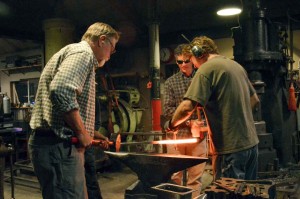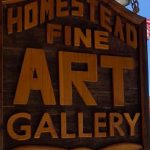History forged at museum
By May Soricelli
The Surveyor

Mark French and David Norrie take the red-hot iron bar from the furnace and hammer a punch through to make a square shaped opening in the center of bar that will eventually allow another bar to pass through when assembled.
May Soricelli / The Surveyor
The Berthoud Historical Society has commissioned the talents of local blacksmith David Norrie to design and forge a fence and gate structure that will connect both of the history museum’s buildings and will decorate the perimeter of the newly completed courtyard. The process of forging the gates has brought to life the methods of the town’s original blacksmith, A.G. Bimson, and his influential trade.
As the structure currently stands, several sections of the fence are in place on the grounds and the center piece is complete. On Oct.7 a large wrought iron fence panel was installed at the museum. The next step of the project is to finalize measurements and begin work on the intricate gates, two in total, to complete the fence. A small piece of fencing is also being constructed for the side of the building to fill in the small gap between buildings.
Work is underway at the forge of local blacksmith and talented artist, Norrie. Norrie has gladly given his abilities and shop as a resource to the historical society as a way to help celebrate Berthoud’s history and invest in its future. For several years, discussions have been had between Norrie and the museum staff about the future possibility of a fence. However, without proper funding they were unable to see the goal realized. In the spring of this year Norrie was approached by the historical society with an allocated budget available to commence the project. Now that the courtyard has been beautifully transformed and the opportunity to fund the project is available, a volunteer-based team has assembled to make history by creating these pieces. Norrie has agreed to design, create, and train several volunteers to build the gates at a fraction of the cost. “I decided, why not get the community involved; why just have me doing it?” said Norrie. “So we began having volunteers invest their time as a community project, not just on my own.” Though it requires more investment, Norrie enjoys taking the time to teach the volunteers the technique and process of metal working. He invites anyone in the Berthoud mailing address to participate in the project.

A section of the iron fencing is placed in front of the museum’s courtyard.
May Soricelli / The Surveyor
The most staggering effort Norrie is making is in his desire to do as much of the work as possible in the traditional methods similar to what would have been used by Bimson. He states that 90-95 percent of the process is true to the traditional ways. For example, the bars of the gates are all hammered by hand, and the welding is done by heating and fusing metal with fiery hot coals verses a welder. Bimson was the man who constructed the building which is now the Little Thompson Valley Pioneer Museum. He created many varieties of items; such as fireplace sets, tools, and even some gates. Norrie requested from the historical society any photographs of the early 1900s which contained some of Bimson’s handiwork so he can replicate the method and designs used.
This is how Norrie came up with the blueprints for the gates. He took similar designs fashioned by Bimson and incorporated them in a way that is “less rustic and more refined, a little more balanced, and nicer looking,” said Norrie. The designs on the gates themselves are particularly visually grabbing and will honor the memory of the blacksmith who once left his mark on the town.
Holes were punched in the railing on Oct. 20 at Norrie’s shop in town. The atmosphere at the forge was in itself a transcending time; the workers lifted the heavy hammers and swung down in rhythmic patterns and sparks sprayed around the glowing red-hot iron posts. The process included heating bars, texturing them, forging the ends, and punching holes by heating and hammering a punch through, using coal fire to heat and fuse the metals together.
The process is not rushed due to the many members of the community who are involved in the project. It takes time to train and assist each one so they can also have their stamp on the history being made. “It’s a high-level process that takes a lot longer with volunteers,” said Norrie. The work is done weekly with as many as 12-15 different volunteers involved to this point. The time frame has been expanded through next year for completion. However, Norrie intends to quickly fabricate temporary gates that will be put into use in order to get through the winter and have a secured structure in place which will be able to lock appropriately.
- June, 10 2021

News Bites – June 10, 2021
On June 3, at about 7:15 a.m., LCSO deputies were dispatched to U.S. Highway 287...
- February, 16 2018

- July, 09 2015

We’ll have our own parade
Collins Park West HOA celebrates the Fourth of July with the World's Shortest Parade [caption...
- June, 19 2014

Obit: Robert (Bob) Ticha
Robert (Bob) Ticha: Sept. 5, 1943 - June 13, 2014 Robert (Bob) Ticha, 70, joined...
- June, 09 2016

Marilyn Jean Krieger: July 11, 1935 &...
Marilyn Jean Krieger, 80, passed away Oct. 31, 2015. She was born on July 11,...
- April, 13 2017

Donald Baxter Davis: March 29, 1926 &...
Donald Baxter Davis was born March 29, 1926, to...

POLICEBLOTTER
Community News
Northern Water sets C-BT quota at 70% for 2024
Community News

Emotions run high during Revere Property hearing
Community News
Snowpack at 119% above normal
Community News

Karspeck to serve third term as Berthoud mayor
Community News

OPINION – No bitchin’ allowed
Community News
Roy Tripi to become principal of BHS on July 1
Community News
COMMUNITY CALENDAR:
Community Calendar – add an event
Homestead Fine Art Gallery First Fridays OPEN HOUSE
03 May 4:00 PM - 7:00 PM
Homestead Fine Art Gallery First Fridays OPEN HOUSE
07 Jun 4:00 PM - 7:00 PM
Homestead Fine Art Gallery First Fridays OPEN HOUSE
05 Jul 4:00 PM - 7:00 PM
Homestead Fine Art Gallery First Fridays OPEN HOUSE
02 Aug 4:00 PM - 7:00 PM
Homestead Fine Art Gallery First Fridays OPEN HOUSE
06 Sep 4:00 PM - 7:00 PM
Homestead Fine Art Gallery First Fridays OPEN HOUSE
04 Oct 4:00 PM - 7:00 PM

